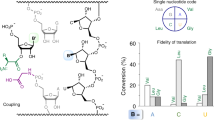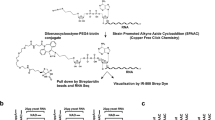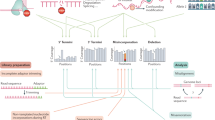Abstract
The 5′ cap is a unique feature of eukaryotic cellular and viral messenger RNA that is absent from the bacterial and archaeal domains of life. The cap is formed by three enzymatic reactions at the 5′ terminus of nascent mRNAs. Although the capping pathway is conserved in all eukaryotes, the structure and genetic organization of the component enzymes vary between species. These differences provide insights into the evolution of eukaryotes and eukaryotic viruses.
This is a preview of subscription content, access via your institution
Access options
Subscribe to this journal
Receive 12 print issues and online access
$189.00 per year
only $15.75 per issue
Buy this article
- Purchase on Springer Link
- Instant access to full article PDF
Prices may be subject to local taxes which are calculated during checkout







Similar content being viewed by others
References
Shuman, S. Structure, mechanism, and evolution of the mRNA capping apparatus. Prog. Nucleic Acid Res. Mol. Biol. 66, 1–40 (2000).
Woese, C. R., Kandler, O. & Wheelis, M. L. Towards a natural system of organisms: proposal for the domains Archaea, Bacteria, and Eucarya. Proc. Natl Acad. Sci. USA 87, 4576–4579 (1990).
Muthukrishnan, S., Both, G. W., Furuichi, Y. & Shatkin, A. J. 5′-terminal 7-methylguanosine in eukaryotic mRNA is required for translation. Nature 255, 33–37 (1975).
Schwer, B., Mao, X. & Shuman, S. Accelerated mRNA decay in conditional mutants of yeast mRNA capping enzyme. Nucleic Acids Res. 26, 2050–2057 (1998).
Schwer, B., Saha, N., Mao, X., Chen, H. W. & Shuman, S. Structure–function analysis of yeast mRNA cap methyltransferase and high-copy suppression of conditional mutants by AdoMet synthase and the ubiquitin conjugating enzyme Cdc34p. Genetics 155, 1561–1576 (2000).
Nilsen, T. W. Evolutionary origin of SL-addition trans-splicing: still an enigma. Trends Genet. 17, 678–680 (2001).
Gingras, A. C., Raught, B. & Sonenberg, N. eIF4 initiation factors: effectors of mRNA recruitment to ribosomes and regulators of translation. Annu. Rev. Biochem. 68, 913–963 (1999).
She, Q. et al. The complete genome of the crenarchaeon Sulfolobus solfataricus P2. Proc. Natl Acad. Sci. USA 98, 7835–7840 (2001).
Slupska, M. M. et al. Leaderless transcripts of the crenarchaeal hyperthermophile Pyrobaculum aerophilum. J. Mol. Biol. 309, 347–360 (2001).
Fitz-Gibbon, S. T. et al. Genome sequence of the hyperthermophilic crenarchaeon Pyrobaculum aerophilum. Proc. Natl Acad. Sci. USA 99, 984–989 (2002).
Deutscher, M. P. & Li, Z. Exoribonucleases and their multiple roles in RNA metabolism. Prog. Nucleic Acid Res. Mol. Biol. 66, 67–105 (2000).
Yue, Z. et al. Mammalian capping enzyme complements mutant S. cerevisiae lacking mRNA guanylyltransferase and selectively binds the elongating form of RNA polymerase II. Proc. Natl Acad. Sci. USA 94, 12898–12903 (1997).
Saha, N., Schwer, B. & Shuman, S. Characterization of human, Schizosaccharomyces pombe and Candida albicans mRNA cap methyltransferases and complete replacement of the yeast capping apparatus by mammalian enzymes. J. Biol. Chem. 274, 16553–16562 (1999).
Takagi, T., Moore, C. R., Diehn, F. & Buratowski, S. An RNA 5′-triphosphatase related to the protein tyrosine phosphatases. Cell 89, 867–873 (1997).
Yokoska, J., Tsukamoto, T., Miura, K., Shiokawa, K. & Mizumoto, K. Cloning and characterization of mRNA capping enzyme and mRNA (guanine-7-)-methyltransferase cDNAs from Xenopus laevis. Biochem. Biophys. Res. Commun. 268, 617–624 (2000).
Tsukamoto, T. et al. Isolation and characterization of the yeast mRNA capping enzyme β subunit gene encoding RNA 5′-triphosphatase, which is essential for cell viability. Biochem. Biophys. Res. Commun. 239, 116–122 (1997).
Wang, S. P., Deng, L., Ho, C. K. & Shuman, S. Phylogeny of mRNA capping enzymes. Proc. Natl Acad. Sci. USA 94, 9573–9578 (1997).
Wang, S. P. & Shuman, S. Structure–function analysis of the mRNA cap methyltransferase of Saccharomyces cerevisiae. J. Biol. Chem. 272, 14683–14689 (1997).
Yamada-Okabe, T. et al. Isolation and characterization of the Candida albicans gene for mRNA 5′ triphosphatase: association of mRNA 5′ triphosphatase and mRNA 5′ guanylyltransferase activities is essential for the function of mRNA 5′ capping enzyme in vivo. FEBS Lett. 435, 49–54 (1998).
Schwer, B., Lehman, K., Saha, N. & Shuman, S. Characterization of the mRNA capping apparatus of Candida albicans. J. Biol. Chem. 276, 1857–1864 (2001).
Shuman, S., Liu, Y. & Schwer, B. Covalent catalysis in nucleotidyl transfer reactions: essential motifs in Saccharomyces cerevisiae RNA capping enzyme are conserved in Schizosaccharomyces pombe and viral capping enzymes and among polynucleotide ligases. Proc. Natl Acad. Sci. USA 91, 12046–12050 (1994).
Pei, Y., Schwer, B., Hausmann, S. & Shuman, S. Characterization of Schizosaccharomyces pombe RNA triphosphatase. Nucleic Acids Res. 29, 387–396 (2001).
Lima, C. D., Wang, L. K. & Shuman, S. Structure and mechanism of yeast RNA triphosphatase: an essential component of the mRNA capping apparatus. Cell 99, 533–543 (1999).
Changela, A., Ho, C. K., Martins, A., Shuman, S. & Mondragon, A. Structure and mechanism of the RNA triphosphatase component of mammalian mRNA capping enzyme. EMBO J. 20, 2575–2586 (2001).
Ho, C. K., Pei, Y. & Shuman, S. Yeast and viral RNA 5′ triphosphatases comprise a new nucleoside triphosphatase family. J. Biol. Chem. 273, 34151–34156 (1998).
Ho, C. K. & Shuman, S. A yeast-like mRNA capping apparatus in Plasmodium falciparum. Proc. Natl Acad. Sci. USA 98, 3050–3055 (2001).
Pei, Y., Ho, C. K., Schwer, B. & Shuman, S. Mutational analyses of yeast RNA triphosphatases highlight a common mechanism of metal-dependent NTP hydrolysis and a means of targeting enzymes to pre-mRNAs in vivo by fusion to the guanylyltransferase component of the capping apparatus. J. Biol. Chem. 274, 28865–28874 (1999).
Bisaillon, M. & Shuman, S. Structure–function analysis of the active site tunnel of yeast RNA triphosphatase. J. Biol. Chem. 276, 17261–17266 (2001).
Katinka, M. D. et al. Genome sequence and gene compaction of the eukaryote parasite Encephalitozoon cuniculi. Nature 414, 450–453 (2001).
Hausmann, S., Vivarès, C. P. & Shuman, S. Characterization of the mRNA capping apparatus of the microsporidian parasite Encephalitozoon cuniculi. J. Biol. Chem. 277, 96–103 (2002).
Silva, E., Ullu, E., Kobayashi, R. & Tschudi, C. Trypanosome capping enzymes display a novel two-domain structure. Mol. Cell. Biol. 18, 4612–4619 (1998).
Ho, C. K. & Shuman, S. Trypanosoma brucei RNA triphosphatase: antiprotozoal drug target and guide to eukaryotic phylogeny. J. Biol. Chem. 276, 46182–46186 (2001).
Baldauf, S. L., Roger, A. J., Wenk-Siefart, I. & Doolittle, W. F. A kingdom-level phylogeny of eukaryotes based on combined protein data. Science 290, 972–977 (2000).
Shuman, S. The mRNA capping apparatus as drug target and guide to eukaryotic phylogeny. Cold Spring Harbor Symp. Quant. Biol. (in the press).
Wainright, P. O., Hinkle, G., Sogin, M. L. & Stickel, S. K. Monophyletic origins of the metazoa: an evolutionary link with fungi. Science 260, 340–342 (1993).
Anantharaman, V., Koonin, E. V. & Aravind, L. Comparative genomics and evolution of proteins involved in RNA metabolism. Nucleic Acids Res. 30, 1427–1464 (2002).
Yu, L., Martins, A., Deng, L. & Shuman, S. Structure–function analysis of the triphosphatase component of vaccinia virus mRNA capping enzyme. J. Virol. 71, 9837–9843 (1997).
Pena, L., Yanez, J., Revilla, Y., Vinuela, E. & Salas, M. L. African swine fever virus guanylyltransferase. Virology 193, 319–328 (1992).
Larsen, M., Gunge, N. & Meinhardt, F. Kluyveromyces lactis killer plasmid pGKL2: evidence for a viral-like capping enzyme encoded by ORF3. Plasmid 40, 243–246 (1998).
Tigemann, M., Jeske, S., Larsen, M. & Meinhardt, F. Kluyveromyces lactis killer plasmid pGKL2: heterologous expression of Orf3p and proof of guanylyltransferase and mRNA-triphosphatase activities. Yeast 18, 815–825 (2001).
Jin, J., Dong, W. & Guarino, L. A. The LEF-4 subunit of baculovirus RNA polymerase has RNA 5′-triphosphatase and ATPase activities. J. Virol. 72, 10011–10019 (1998).
Guarino, L. A., Jin, J. & Dong, W. Guanylyltransferase activity of the LEF-4 subunit of baculovirus RNA polymerase. J. Virol. 72, 10003–10010 (1998).
Martins, A. & Shuman, S. Mutational analysis of baculovirus capping enzyme Lef4 delineates an autonomous triphosphatase domain and structural determinants of divalent cation specificity. J. Biol. Chem. 276, 45522–45529 (2001).
Martins, A. & Shuman, S. Mechanism of phosphoanhydride cleavage by baculovirus phosphatase. J. Biol. Chem. 275, 35070–35076 (2000).
He, J. G. et al. Complete genome analysis of the mandarin fish infectious spleen and kidney necrosis iridovirus. Virology 291, 126–139 (2001).
Van Etten, J. L. & Meints, R. H. Giant viruses infecting algae. Annu. Rev. Microbiol. 53, 447–494 (1999).
Håkansson, K., Doherty, A. J., Shuman, S. & Wigley, D. B. X-ray crystallography reveals a large conformational change during guanyl transfer by mRNA capping enzymes. Cell 89, 545–553 (1997).
Gong, C. & Shuman, S. Chlorella virus RNA triphosphatase: mutational analysis and mechanism of inhibition by tripolyphosphate. J. Biol. Chem. 277, 15317–15324 (2002).
Iyer, L. M., Aravand, L. & Koonin, E. V. Common origin or four diverse families of large eukaryotic DNA viruses. J. Virol. 75, 11720–11734 (2001).
Author information
Authors and Affiliations
Glossary
- APICOMPLEXA
-
A taxon of protozoa that includes the pathogens Plasmodium, Toxoplasma, Eimeria and Cryptosporidium.
- CRENARCHAEA
-
One of two kingdoms within the archaeal domain, the other being Euryarchaea.
- EPISOME
-
An extrachromosomal genetic element.
- EUGLENOZOA
-
A taxon of protozoa that includes the pathogens Trypanosoma and Leishmania.
- METAZOA
-
Multicellular animals that are composed of differentiated cells.
- MICROSPORIDIA
-
Small spore-forming unicellular eukaryotes that have an obligate intracellular parasitic lifestyle.
- PHYLOGENY
-
The evolutionary history of organisms.
- PROTEOME
-
The catalogue of predicted proteins that is encoded by an organism's genome.
- PROTOZOA
-
Unicellular animals.
- TAXA
-
The names of the taxonomic groups.
- TAXONOMY
-
An orderly classification of species according to their presumed natural relationships.
Rights and permissions
About this article
Cite this article
Shuman, S. What messenger RNA capping tells us about eukaryotic evolution. Nat Rev Mol Cell Biol 3, 619–625 (2002). https://doi.org/10.1038/nrm880
Issue Date:
DOI: https://doi.org/10.1038/nrm880
This article is cited by
-
N6-methyladenosine modification enables viral RNA to escape recognition by RNA sensor RIG-I
Nature Microbiology (2020)
-
FTSJ3 is an RNA 2′-O-methyltransferase recruited by HIV to avoid innate immune sensing
Nature (2019)
-
The mRNA capping enzyme of Saccharomyces cerevisiae has dual specificity to interact with CTD of RNA Polymerase II
Scientific Reports (2016)
-
Polintons: a hotbed of eukaryotic virus, transposon and plasmid evolution
Nature Reviews Microbiology (2015)
-
Listeria monocytogenes: a model pathogen to study antigen-specific memory CD8 T cell responses
Seminars in Immunopathology (2015)



